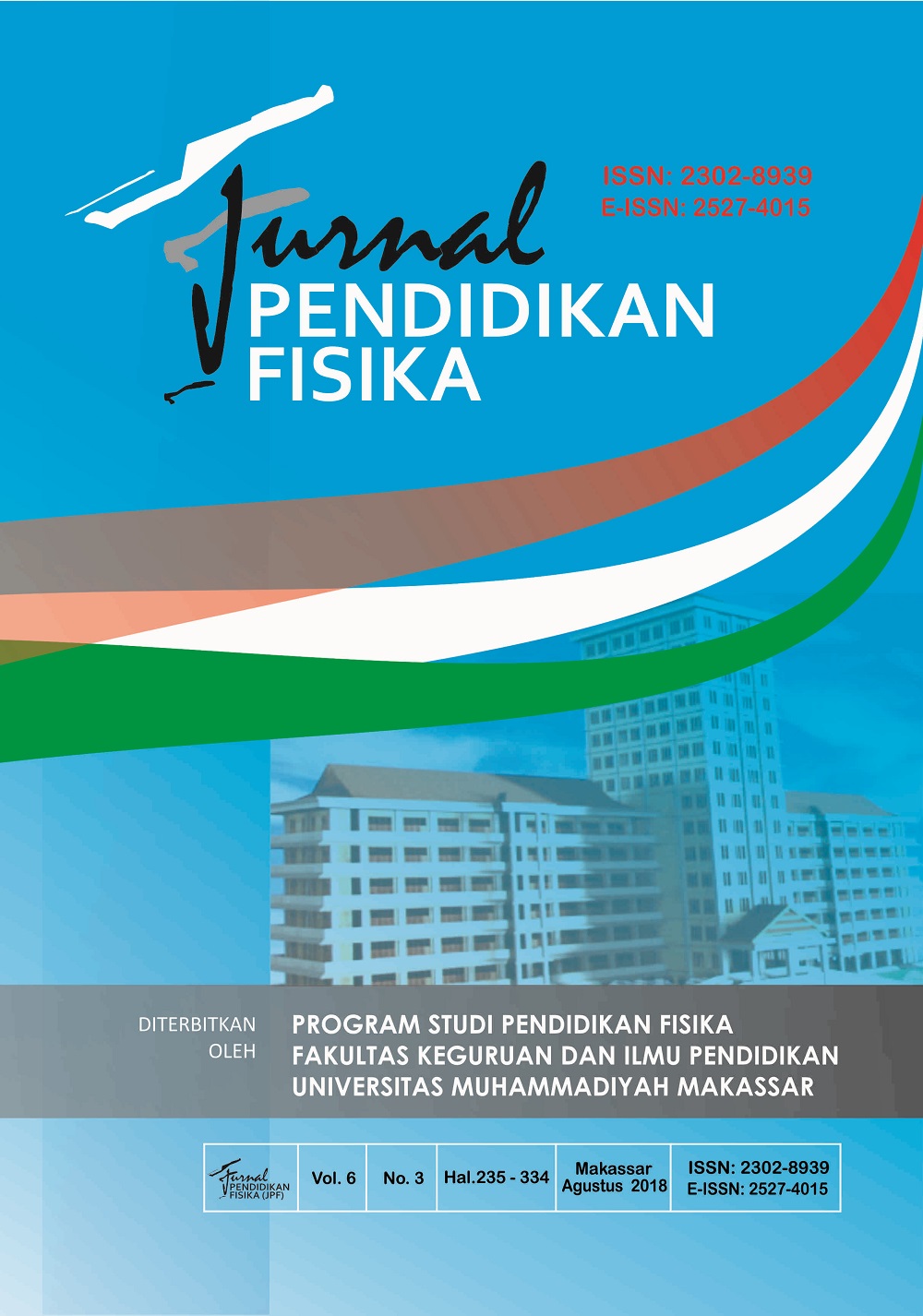Computer Assisted Instruction (CAI) Use Of Physics Learning Research Group (PLRG) Simulator To Increase Concept Mastery
DOI: https://doi.org/10.26618/jpf.v6i3.1411
Abstract
Perkembangan Teknologi Informasi dan Komunikasi (TIK) telah memberikan kontribusi yang signifikan dalam bidang pendidikan. Pembelajaran yang lebih individual dan fleksibel dengan penekanan pada metode instruksi sedang menjadi tren yang berkembang di seluruh dunia. Penelitian ini menekankan pada penggunaan komputer dalam proses belajar mengajar untuk memberikan instruksi dalam situasi kelas. Model Pembelajaran CAI berbantuan Physics Learning Research Group (PLRG) simulator digunakan untuk meningkatkan penguasaan konsep siswa. PLRG simulator menekankan konsep fisika berbasis penyelidikan ilmiah bagi siswa sekolah dasar hingga perguruan tinggi. Populasi yang digunakan adalah siswa kelas X Sekolah Menengah Atas (SMA). Berdasarkan hasil penelitian, disimpulkan bahwa Model Pembelajaran CAI berbantuan Physics Learning Research Group (PLRG) simulator dapat meningkatkan penguasaan konsep siswa. Hal ini ditunjukkan oleh nilai N-gain yang diperoleh oleh siswa pada kelas eksperimen. Peningkatan kemampuan penguasaan konsep siswa rata-rata berada pada kategori sedang.
Kata kunci: Model Pembelajaran CAI, PLRG Simulator, dan Penguasaan Konsep
The development of information and communication technology has contributed significantly in education. More individual and flexible learning with an emphasis on instruction methods is becoming a growing trend throughout the world. This study emphasizes the use of computers in the teaching and learning process to provide instruction in classroom situations. The CAI learning model used of the Physics Learning Research Group (PLRG) simulator is used to improve the mastery of students' concepts. PLRG simulators emphasize the concept of physics based on scientific inquiry for elementary school to college students. The population used is students of class X High School. Based on the results of the study, it was concluded that the CAI Learning Model use of Physics Learning Research Group (PLRG) simulator could improve the mastery of students' concepts. This is indicated by the N-gain values obtained by the students in the experimental class. The improvement of students' concept mastery ability is on average in the medium category.
Keywords: CAI Learning Model, PLRG Simulator, and Concept MasteryReferences
Banik, Sarmistha dan Bismas. Effects of Computer Assisted Instruction (CAI) on The Teaching of Current Electricity at Higher Secondary Level. International Journal of Advanced Scientific Research & Development. 04. 13 -23.
Depdiknas. 2003. Undang-Undang RI No. 20 tahun 2003 tentang sistem pendidikan nasional
Onasanya, S. A., Daramola, F. O., & Asuquo, E. N. (2006). Effect of Computer Assisted Instructional Package on Secondary School Students’ Achievement in Introductory Technology in Ilorin, Nigerian. The Nigeria Journal of Educational Media and Technology, 12(1), 98-107.
Siahaan, Herta R dan Wahyuni, Ida. Pengaruh Model Pembelajaran Kooperatif Tipe Team Game Tournament (TGT) terhadap Hasil Belajar Siswa. Jurnal Inovasi Pembelajaran Fisika. 6 (1), 26 – 33.
Sugiono. 2010. Metode Penelitian Pendidikan Pendekatan Kuantitatif, Kualitatif, dan R&D. Bandung : Alfabeta
Surjono, Herman Dwi. Pengembangan Computer Assisted Instruction (CAI) untuk Pelajaran Elektronika. Jurnal Kependidikan. 27 (2). 95 – 106.
Sulaeman, dkk. 2017. Effects of Computer-Assisted Instruction (CAI) on Students’ Academic Achievement in Physics at Secondary Level. Jurnal of Computer Engineering and Intelligent Systems . 8 (7). 9 -17.
Downloads
Published
How to Cite
Issue
Section
License
Copyright:
Authors who publish with this journal agree to the following terms:
1. Authors retain copyright and grant the journal right of first publication with the work simultaneously licensed under a Creative Commons Attribution-ShareAlike 4.0 International License that allows others to share the work with an acknowledgement of the work's authorship and initial publication in this journal.
2. Authors are able to enter into separate, additional contractual arrangements for the non-exclusive distribution of the journal's published version of the work (e.g., post it to an institutional repository or publish it in a book), with an acknowledgement of its initial publication in this journal.
3. Authors are permitted and encouraged to post their work online (e.g., in institutional repositories or on their website) prior to and during the submission process, as it can lead to productive exchanges, as well as earlier and greater citation of published work.
Licence:
Authors are free to:
1. Share: Copy and redistribute the material in any medium or format
2. Adapt: Remix, transform, and build upon the material for any purpose, even commercially.
The licensor cannot revoke these freedoms as long as the authors follow the license terms, which include the following:
1. Attribution: You must give appropriate credit, provide a link to the license, and indicate if changes were made. You may do so in any reasonable manner, but not in any way that suggests the licensor endorses you or your use.
2. ShareAlike: If you remix, transform, or build upon the material, you must distribute your contributions under the same license as the original.
3. No additional restrictions: You may not apply legal terms or technological measures that legally restrict others from doing anything the license permits.
Jurnal Pendidikan Fisika is licensed under a Creative Commons Attribution-ShareAlike 4.0 International License.






